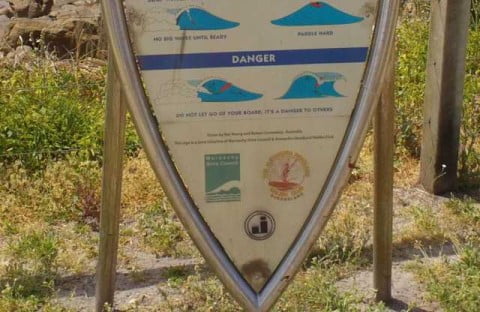The temperature is tipped to hit 30° today here in Brisbane, yesterday I took the pool blanket off in preparation for the school holidays that start next week. Elizabeth, for sure, will want to be going swimming; all I need to do now is to test the pool water to make sure everything is as it should be.
Swimming pool opening and closing times are almost set in stone here, as I explained in my post called Swimming Pools in Australia.
Winter turns to summer in a blink of an eye here, almost as if spring doesn’t exist. But maybe its winter that doesn’t exist? Moving on.
Those in Australia that do live closer to the beach than we do will probably do the majority of their swimming in the sea. One advantage of swimming in the sea is you can surf. I have never been surfing; I can’t stand on one leg with my eyes shut, so I don’t fancy my chances balancing on a board that is floating on a wave.
If I were to surf though, I would have to follow…
The Surfers Code
 Okay, let’s run through it together.
Okay, let’s run through it together.
Right of Way
This means the person closest to the peak of a breaking wave has the right of way, or the right to ride it.
Do Not
Drop-in means don’t try and jump on a wave where somebody else has the right of way, see above. Snaking is when a surfer paddles to the inside of a surfer who is taking off in the prime spot, and is not the done thing.
Paddling Out
You should paddle wide of the waves, so you don’t get in the way of someone riding in on them. When paddling out, if you get caught in a wave, stay in the white water means avoid the peak of the wave where somebody may well be riding. But if you paddled out wide as you should’ve done, you shouldn’t get caught in a wave.
Remember to Communicate
When you’ve caught a wave, let others around you know by shouting out something like “I’ve caught a wave!” And then maybe tell them which direction you’re going. Something like “I’m going left!” Or “I’m going right!”
Always
Surf within your ability, don’t take on any big waves until you’re ready, paddle hard and take off with commitment. All straightforward stuff there.
Danger
The instructions for danger didn’t quite fit in on my photograph, no worries, I’ve got it below. But I know you are all very worried at this stage, some of these may even be thinking about the film “Jaws” or some other negative thoughts here.
What is this danger of which they speak? Before your mind gets too carried away, let’s jump straight to it…
 Don’t let go of your board, that’s it! Your surfboard should have a piece of rope attached to it which you hold onto at all times. If you let go of your board, it could bash somebody on the head. That’s it, danger over. What else can possibly go wrong? Don’t quote me on that.
Don’t let go of your board, that’s it! Your surfboard should have a piece of rope attached to it which you hold onto at all times. If you let go of your board, it could bash somebody on the head. That’s it, danger over. What else can possibly go wrong? Don’t quote me on that.
All you have to do now is learn how to surf. Let’s head off to the Sunshine Coast, exact place where I took the photograph of that sign, to get a quick surfing lesson Aussie style…
Surfing isn’t just an Australian thing though; it’s big in the USA and all around the globe. Even in the UK. The Pembrokeshire Coast is actually in Wales, and these guys are going to show you how to surf in less than 3 minutes
Now you can surf, you’ll probably get bitten by the bug; enter competitions, star in movies, that sort of thing…
Happy surfing dude!





